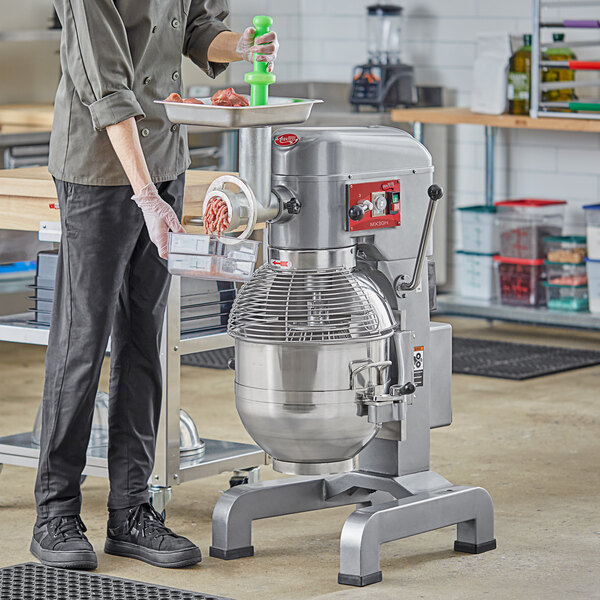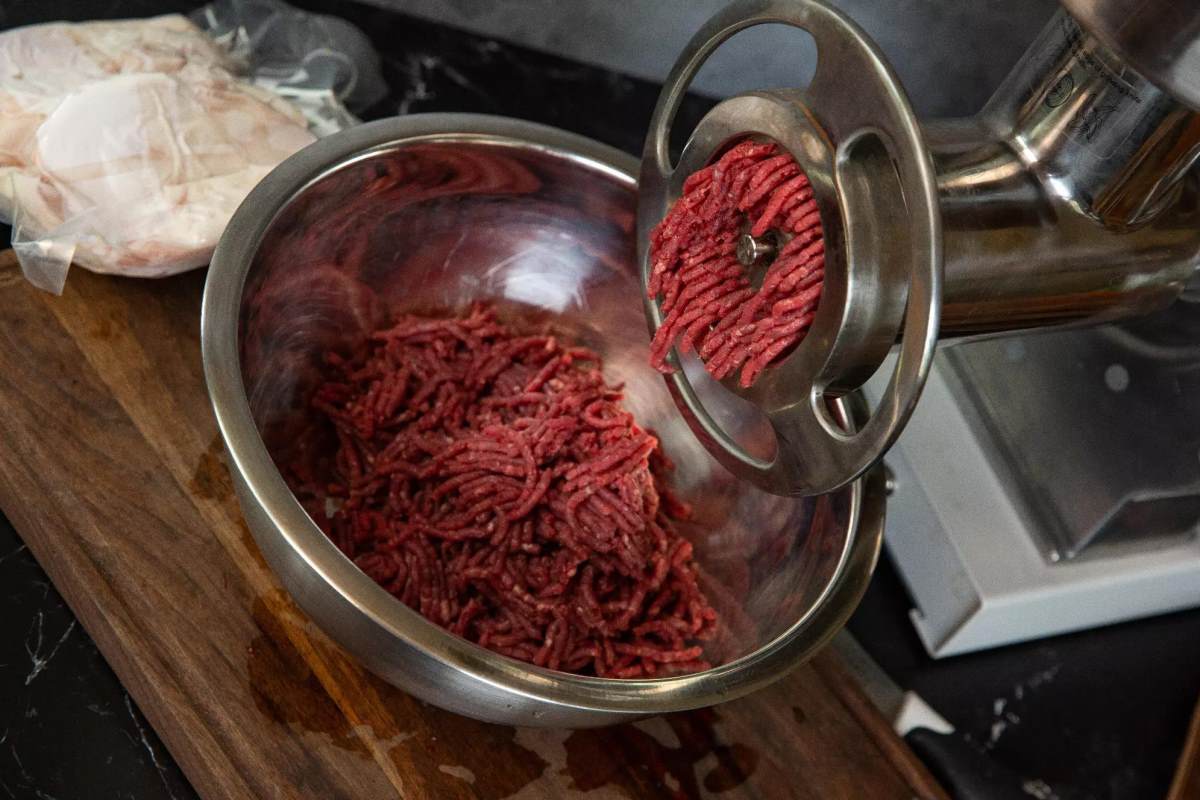Yes, you can use a meat grinder to grind grains, but it may not be the most efficient tool. A meat grinder with the appropriate attachment can process grains into a coarse flour.
Exploring alternative uses for kitchen appliances can often lead to pleasant surprises, such as the versatility of a meat grinder. While these devices are specifically designed to break down tougher meat fibers, they can also tackle the hardy textures of various grains.
Allowing a meat grinder to take on this task necessitates a coarse grind setting and the right attachments, usually referred to as milling plates or burrs. Yet, there’s an important caveat: meat grinders won’t match the fine consistency achieved by actual grain mills. Keen home chefs or avid bakers who appreciate DIY flours can experiment with meat grinders for small-batch grain grinding. It’s crucial to consider both the capabilities of your grinder and the desired texture for your end-product, as some grains may be too hard and could potentially damage the appliance.
Versatile Kitchen Tools: Meat Grinders?
Meat grinders are indeed versatile but not ideal for grinding grains. Designed to cut through tough meat, meat grinders handle grains differently. Grains need consistent, fine milling. A meat grinder may fail to achieve this texture. Grains are hard and can wear down the mechanism. Regular use for grains may damage your meat grinder.
Grains, such as wheat, corn, and rice, have distinct structures. They have a hard outer layer called the bran. Inside, the germ and endosperm provide nutrients. These parts must be finely ground for flour or meal. Specialised grain mills ensure even milling.
| Grinder Type | Suitable for Grains? |
|---|---|
| Meat Grinder | Not Recommended |
| Grain Mill | Highly Recommended |
- Consider the job you need to do.
- Choose the right tool for grinding grains.
- Avoid harm to your kitchen appliances.
Meat Grinders And Their Functionality
Meat grinders are versatile tools designed primarily to grind meats. Their powerful motors and sharp blades break down the meat into finer pieces. The process involves pushing meat through a feed tube, where it meets a cutting blade and grinding plate. Different attachments can determine the coarseness of the grind.
There are main types of meat grinders: manual and electric. Manual grinders require physical effort, using a hand crank to grind the meat. Electric grinders, on the other hand, function with the press of a button. People typically find electric models more efficient and less tiring. For occasional use, a manual grinder may suffice. But for frequent, large batches, electric grinders are the preferred choice.
Grain Grinding: A Comparison
Many kitchens have a meat grinder, but not all know its grain grinding ability. A meat grinder can handle dry grains, though it’s not its main job. It works in a pinch but may not give the fine flour expected from a grain mill. Grain mills work better for grains. They are designed to produce the perfect flour texture.
Modern kitchen gadgets offer new ways to grind grains. These machines promise ease and efficiency. They include coffee grinders and high-powered blenders. Each device varies in its effectiveness for grain grinding. It’s important to choose the right appliance for desired results.
| Appliance | Effectiveness |
|---|---|
| Meat Grinder | Usable, not ideal |
| Grain Mill | Highly effective |
| Coffee Grinder/Blender | Varies |

Credit: www.webstaurantstore.com
Cross-utilization Of Meat Grinders
Many kitchens have meat grinders that also serve alternative uses. Users often grind grains with their meat grinders. This practice is not new and has precedents in various cuisines. Some meat grinders come with attachments specifically for grains. But, most meat grinders are primarily designed for meat, not grains.
This can lead to performance issues when grinding non-meat items. Limited settings may not yield the desired grain consistency. Also, grains can be harder on the grinder’s blades. This could cause wear and damage over time. It’s important to consider the capabilities and limitations of your equipment.
| Grain Type | Consideration |
|---|---|
| Wheat | Requires coarse grinding |
| Corn | May be too hard for some grinders |
| Rye | Often needs a fine grind |
Always check the manufacturer’s guidelines before using a meat grinder for grains. Not all machines are suitable for this type of task. Some may handle the job easily, but others could break or wear out faster.
Technical Considerations
A meat grinder’s blade configuration matters a lot for grinding grains. Normal meat grinder blades are designed to cut through soft animal tissues. Grains require different blade configurations that can handle harder materials. This means meat grinder blades might not be suitable for such tasks without the right adjustments or blade replacements.
Grinding grains demands more power and durability from the motor compared to meats. Many meat grinders come with motors not optimized for the hard work of grinding grains. This could lead to motor burnout or ineffective grinding. Users need to check their meat grinder’s power rating and motor capabilities before attempting to grind grains to avoid potential damage.

Credit: www.petersenshunting.com
Practical Experiments
Many kitchen adventurers have tried to mill grains with meat grinders. Some found surprising success while others met with fair challenges. A user reported that hard grains like wheat could grind well. Their meat grinder handled the task decently enough for bread. A tip from another was to use a heavy-duty grinder and to feed the grains slowly.
A different user found that softer grains, such as oats, would sometimes clog the meat grinder. However, mixing with harder grains improved the flow. Thorough cleaning after use was a common emphasis by many users. They warned that grain residues can lead to rust or mold if not properly taken care of.
- Successful grain grinding: mostly with hard grains.
- Use of a heavy-duty meat grinder recommended.
- Clogging may occur with softer grains.
- Mixed grains can help avoid jamming.
- Cleaning is crucial to maintaining the grinder.
Pros And Cons Of Grinding Grains With Meat Grinders
Utilizing meat grinders for grinding grains can be an appealing option. These multi-use appliances save space and cost. Users enjoy the simplicity of one device for multiple kitchen tasks. Grinding grains with a meat grinder can also be faster than traditional methods.
Nevertheless, meat grinders aren’t designed for grains. This mismatch can lead to inconsistent grinding results. It may also cause damage to the appliance. To mitigate these issues, invest in specific attachments or blades designed for grains. Regular maintenance is essential. Never overload the grinder to prevent strain on its motor.
| Benefits | Potential Issues | Solutions |
|---|---|---|
| Space-saving | Inconsistent results | Grain-specific attachments |
| Cost-effective | Appliance wear and tear | Regular maintenance |
| One device, many uses | Overloading risk | Avoid excessive strain |

Credit: www.amazon.com
Expert Advice And Alternative Solutions
Experts suggest using dedicated grain mills. A meat grinder might not yield desired results for grains. The design specializes in tougher meats. Intended use is crucial for appliance longevity and food safety. Instead, browse dedicated grain mill options. Home bakers and professionals prefer these. They ensure efficient grinding and consistency.
| Appliance | Grinding Quality | Suitability |
|---|---|---|
| Burr Grinder | Uniform | Excellent for coffee, not grains |
| Food Processor | Variable | Good for small batches |
| Grain Mill | Fine to coarse | Perfect for all grains |
Research the best grain mill suited for your needs. Professional chefs prefer stone mills for their versatility. Yet, for kitchen novices, a simple electric grinder is user-friendly. Read reviews and product specifications before buying. Ensure the grinder supports the types of grains you wish to grind.
Frequently Asked Questions Of Can I Use A Meat Grinder To Grind Grains
Can Meat Grinders Handle Grinding Grains Effectively?
Most meat grinders are primarily designed for meats, not grains. However, some robust meat grinders with appropriate attachments can grind grains coarsely. It is crucial to check the manufacturer’s specifications before attempting to grind grains with a meat grinder.
What Grains Can You Grind In A Meat Grinder?
Typically, softer grains like rice, barley, or oats may be ground in a meat grinder. Harder grains, like wheat or corn, require more powerful machines or specific grain attachments to ensure a fine grind and avoid damaging the appliance.
Is A Meat Grinder As Good As A Grain Mill?
No, a meat grinder is not as efficient as a grain mill for grinding grains. Grain mills are specially designed to produce a finer, more consistent grind, which is preferred for baking and cooking purposes.
How Can I Adjust The Grind Consistency With A Meat Grinder?
The grind consistency can be adjusted by using different grinding plates with varying hole sizes. A finer plate results in finer grains, while a coarser plate leads to a rougher texture. It is important to grind in small batches to maintain consistency.
Conclusion
Wrapping up, a meat grinder can indeed tackle grains, but with caveats. Opt for specialized grinders for the best results. Experiment sparingly, and prioritize equipment designed for your needs. By doing so, you’ll maintain both the integrity of your grains and the longevity of your grinder.
Happy grinding!
